- Resource recovery
- Resource recovery from excreta, faecal sludge or wastewater
- Production of biochar, fuel or electricity
- Sol-Char Toilet: Using Concentrated Solar Energy to Treat Fecal Waste and Produce a Valuable Soil Amendment - biochar (Uni Colorado, USA)
Sol-Char Toilet: Using Concentrated Solar Energy to Treat Fecal Waste and Produce a Valuable Soil Amendment - biochar (Uni Colorado, USA)
36.6k views
Re: Sol-Char Toilet: Using Concentrated Solar Energy to Treat Fecal Waste and Produce a Valuable Soil Amendment - biochar (Uni Colorado, USA)
Some discussions that followed indicated that we should hold some type of workshop or symposium, perhaps in South Africa, on solar applications for sanitation as a number of talks in the session we presented in focused on this and the session was well attended. Clearly, solar resources are underutilized where they are plentiful and innovations are needed to support sanitation objectives.
If you have an interest in our work, message me here or via email (This email address is being protected from spambots. You need JavaScript enabled to view it.) and we can discuss collaborations. You can follow our past work on the web at: www.colorado.edu/solchar
Please log in or register to see it.
Helen and Huber Croft Professor of Environmental Engineering
Civil, Environmental, and Architectural Engineering
University of Colorado Boulder
428 UCB; 1111 Engineering Drive, ECOT 441
Boulder, CO 80309
Phone: (303) 492-4798, Fax: (303) 492-7317
E-mail: This email address is being protected from spambots. You need JavaScript enabled to view it.
Web: ceae.colorado.edu/klinden/
Twitter: @waterprof
This message has an attachment file.
Please log in or register to see it.
Please Log in to join the conversation.
You need to login to reply- richardpfisher
-

- Researcher at the University of Colorado at Boulder. Reactor team leader for the Sol-Char Toilet, a Reinvent the Toilet Challenge project funded by the Bill and Melinda Gates Foundation
Less- Posts: 5
- Likes received: 0
Re: Sol-Char Toilet: Using Concentrated Solar Energy to Treat Fecal Waste and Produce a Valuable Soil Amendment - biochar (Uni Colorado, USA)
Thanks for letting us know that the paper isn't free. I'll be sure to alert the author and hopefully the foundation will be able to work with the publisher (ACS) to make the paper accessible for free.
I was just reviewing the Foundation's open access policy, it looks like through 2016 the foundation will allow a 12-month period in which the publishers can require payment to view publications but must comply with their open access policy thereafter. So by those terms, the paper that Joe referenced should be available for free in July 2015. Please, though, do not take that prediction as fact because I'm not familiar with any of the subtleties of the Foundation's policy.
The paper in the link that Joe provided is about the heating value of char briquettes made from feces by pyrolysis. The results essentially showed that fecal char briquettes have similar heating value to that of commercial charcoal briquettes (for barbecue that you would buy at the store) and bituminous coal.
To answer the future publication question: we will hopefully have at least three publications this year. I co-authored two papers that will soon be ready for submission to journals and will co-author one more that will be ready for submission by this summer.
I hope that helps! We'll get to work on the paywall issue with the paper by Ward, Yacob, and Montoya.
Thanks,
Chip Fisher
Please Log in to join the conversation.
You need to login to reply- Elisabeth
-
- Moderator
- Freelance consultant since 2012 (former roles: program manager at GIZ and SuSanA secretariat, lecturer, process engineer for wastewater treatment plants)
Less- Posts: 3372
- Karma: 54
- Likes received: 932
Re: Solar Sanitation for Fecal Sludge Management (Sanivation - upcoming pilot in Kakuma refugee camp, Kenya)
I was just looking over old posts and I found this post of yours (thanks for always alerting us to new research papers that are coming out!). I have now moved it into this thread because it belongs to the project at University of Colorado Boulder, USA. Chip recently provided an update on this project, please scrol up.
To answer your question, they are using concentrated solar energy with those fibreglass optics for heating.
Even though they didn't get further funding for this (or let's say not from the Gates Foundation at least for the time being), I am sure there are still lots of interesting research aspects about these biochar briquets that came out.
Chip: Do you have an open-access publications coming out on this (the one that Joe linked to above is behind a paywall). Keeping in mind that the BMGF now embraces a full open access policy, see here:http://forum.susana.org/forum/categories/139-grants-schemes-and-webinars-of-bill-and-melinda-gates-foundation/11118-gates-foundation-mandates-open-access-cc-by-for-all-its-funded-research
Regards,
Elisabeth
Freelance consultant on environmental and climate projects
Please Log in to join the conversation.
You need to login to reply- joeturner
-
 Less
Less- Posts: 717
- Karma: 23
- Likes received: 185
Re: Solar Sanitation for Fecal Sludge Management (Sanivation - upcoming pilot in Kakuma refugee camp, Kenya)
pubs.acs.org/doi/abs/10.1021/es500197h
The paper title is "Evaluation of Solid Fuel Char Briquettes from Human Waste"
The abstract says
The study determined the energy content and the elemental composition of chars pyrolyzed at 300, 450, and 750 °C. Fecal chars made at 300 °C were found to be similar in energy content to wood chars and bituminous coal, having a heating value of 25.6 ± 0.08 MJ/kg, while fecal chars made at 750 °C had an energy content of 13.8 ± 0.48 MJ/kg. The higher heating values of the studied chars were evaluated using their elemental composition and a published predictive model; results found good agreement between the measured and predicted values. Fecal chars made at low temperatures were briquetted with molasses/lime and starch binders. Briquettes made with 10% starch had an average impact resistance index of 79 and a higher heating value of 25 MJ/kg. These values are comparable to those of commercial charcoal briquettes, making fecal char briquettes a potential substitute that also contributes to the preservation of the environment.
I can't really work out from the diagram in the paper whether the idea is to generate electricity from the solar cell or somehow whether solar heating is being used, but I thought it might be interesting to highlight here.
Please Log in to join the conversation.
You need to login to reply- richardpfisher
-

- Researcher at the University of Colorado at Boulder. Reactor team leader for the Sol-Char Toilet, a Reinvent the Toilet Challenge project funded by the Bill and Melinda Gates Foundation
Less- Posts: 5
- Likes received: 0
Re: Sol-Char Toilet: Using Concentrated Solar Energy to Treat Fecal Waste and Produce a Valuable Soil Amendment (Uni Colorado, USA)
About our RTT project:
Unfortunately, we will not be moving forward with our own Reinvent the Toilet Challenge prototype. The foundation has encouraged us to consult with other RTT teams that wish to incorporate high temperature concentrated solar power into their prototypes. Through September 2014, we will be continuing on with our research efforts as the project wraps up. So there are going to be several publications coming out on topics ranging from solar physics to biochar characterization. It'll be exciting work in the coming months!
So to address your comment about achieving the Reinvent the Toilet Challenge goals in 16-24 months:
Since we won't be developing another prototype, we probably won't have the opportunity to develop our technology at lower cost. But we had envisioned the next prototype including a pre-drying step using "lower-grade" heat from a small parabolic trough then using a small parabolic dish to quickly pyrolyze the pre-dried waste. This unit would have served on the order of 50 people per sunny day and used less expensive concentrating solar components, e.g. sans fiber optics, and included waste storage for weather events such as week-long overcast. This unit would have met the foundation's user cost target ($0.05/person/day) for an estimated capital cost of about $10,000-11,000. There's a lot of assumptions embedded in that estimate that I'll save for another post.
To answer your questions about climatic factors such as hail:
Later on this summer, we will hopefully test our reactor and fibers under prolonged weather exposure in order to assess their performance degradation over time. In typical CSP plants for electricity generation, there can be significant O&M but one must keep in mind that those plants have km^2 areas of mirrors – so small inefficiencies translate to major reductions in the total power production. Luckily, our system has about 2m^2 of mirror area, so with our relatively small system we have not been as concerned about minor efficiency losses due to a dirty or dusty mirror surface.
Hail damage could cause problems but I suspect they would have to be large diameter hail; the mirror substrate is solid aluminum, no less than 10mm thick at any point. The reflective surface itself was designed by 3M (famous for Scotch tape) for deployment into harsh environments, such as the US desert southwest, where high winds and sand/dust storms are common. The small turning mirror surfaces are more delicate but it’s not hard to envision a robust housing for weather protection, which came in as a low-risk of failure in our analyses. It would be really neat to see what kind of impact a hail storm would have on our mirrors though because Colorado summers see many hail storms each year.
We didn't spend time on any of the above failure mechanisms because, frankly, we had more catastrophic failure modes with which to concern ourselves. Up until last summer, we melted every fiber bundle that we could get our hands on -- keep in mind that these fibers are borosilicate glass with an initial melting temperature of about 700 degC. We were definitely in peril of not demonstrating even a proof-of-concept so field-readiness and prototype cost took a backseat as a result of the technical challenges we faced. It's not that fibers are delicate or fickle, it's more that only three firms in the US (or world from what we can tell) actually make fused glass optical fiber and they're not easy to find. So we have operated in an empty space, on the lunatic fringe as we affectionately call it, because of our unique technology and application.
Thanks, again! We’ll keep posting updates from any research we are able to perform and collaborations that materialize throughout the summer.
Best,
Chip Fisher
Senior Professional Research Assistant
Sol-Char Sanitation
Please Log in to join the conversation.
You need to login to replyRe: Sol-Char Toilet: Using Concentrated Solar Energy to Treat Fecal Waste and Produce a Valuable Soil Amendment (Uni Colorado, USA)
I watched the Sol-char demonstration video from Reinvent the Toilet Fair in Delhi (see here: forum.susana.org/forum/categories/139-in...videos-now-available or below
You mention in the first video that you will be ready to implement in the field in about 16 to 24 month….
It would be interesting, how far the goals of the RTTC grants will be reached by then (www.susana.org/docs_ccbk/susana_download...y-2013-version-2.pdf):
Create a toilet that:
- removes pathogens from human waste and recovers valuable resources such as energy, clean water, and nutrients.
- operates “off the grid” without connections to water, sewer, or electrical lines.
- costs less than 5 cents per user per day: the anticipated capital and operational cost for the final products (commercial units) is expected to be less than $0.05/user/day, both for the family and neighborhood solutions1.
I would be particularly interested to know if the team has thought about testing the "off-grid" functionality of the system on a long-term, I am a little bit skeptical regarding O&M requirements and robustness to climatic factors (e.g hale)
Kind regards
Dorothee
P.S. Some more photos if you can't watch the Youtube videos:
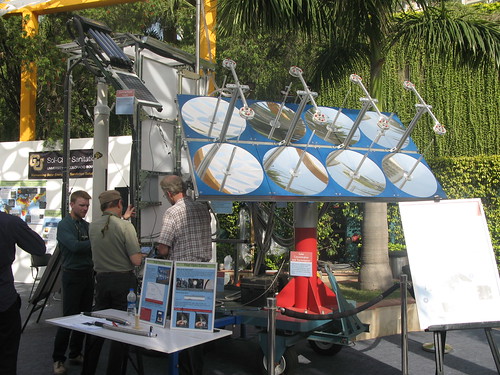
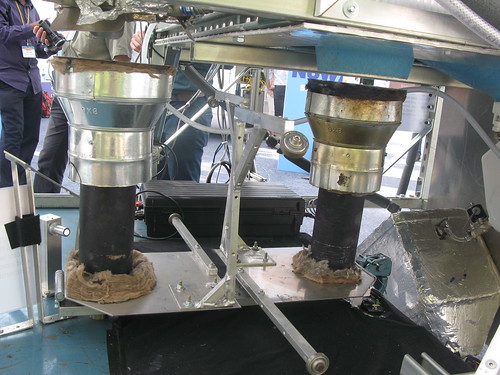
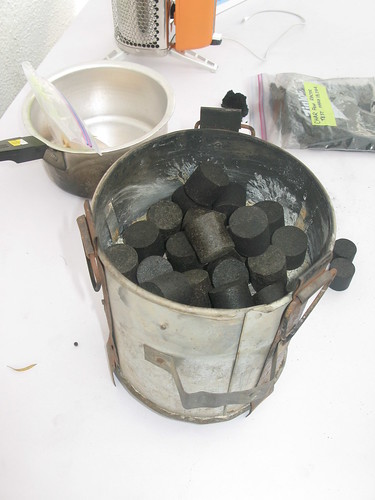
And some more photos are available in this set on Flickr:
www.flickr.com/photos/gtzecosan/sets/72157643960235934
Developing methods and tools to support strategic planning for sustainable sanitation. Particular interested in novel technologies contributing to more inclusive and circular sanitation. This email address is being protected from spambots. You need JavaScript enabled to view it.
Please Log in to join the conversation.
You need to login to reply- rahulingle
-

- Moderator
Less- Posts: 107
- Karma: 2
- Likes received: 18
Attractive interface design though not clear how one would use it.
Rahul Ingle
Please Log in to join the conversation.
You need to login to reply- richardpfisher
-

- Researcher at the University of Colorado at Boulder. Reactor team leader for the Sol-Char Toilet, a Reinvent the Toilet Challenge project funded by the Bill and Melinda Gates Foundation
Less- Posts: 5
- Likes received: 0
I am providing answers to your follow-up questions below.
Chip's Presentation:
Your question under point 3:
There are some photos attached below. In the case of cloudy days, the current prototype will not disinfect waste. For a phase II prototype (if we get the chance to make one!), we would incorporate electric heaters or higher storage capacity to account for days/weeks of no-sun. These changes would involve a new reactor design and reconfiguration of the system.
Your question under point 6:
I wouldn't describe the concentrators as flimsy, they're machined from solid 25mm aluminum blocks. The reflective surface, however, is easier to damage - it's basically a polymer that we can adhere to the aluminum dish. The film is more robust against environmental damage than one might think - it's a reflective film that's used in the US desert southwest for concentrated solar power to electricity plants (think sand and dust storms). For the sake of time, we made the concentrators out of solid aluminum but if we ever sold a toilet with our CSP and reactor system, the concentrators would be made of an entirely different material that doesn't shine and scream, "I'm super expensive, please steal me and sell me." Most likely fiberglass or something similar.
Ryan's Presentation:
Your question under point 1:
The pathogens in urine which we have evaluated are E. Coli and MS2 phage (a surrogate organism for viruses). It is true that healthy urine is sterile, however there is evidence that in urine diversion scenarios, there can be significant fecal contamination of urine.
Your question under point 5:
The better heating value from lower-temperature biochar is not necessarily expected, but due to the relatively high concentration of ash in this feedstock the energy density does infact decrease. With some feedstocks, the higher temperature actually further concentrates the energy because the bonds which are formed arrange themselves in a more energy dense way (thus the MJ/kg HHV will increase). However, because the ash content of feces is relatively high (~5%) this non-combustible portion becomes a larger fraction of the total post-charring (~15% at 300C, 50% at 750C). The end use of the char we generate is still undetermined (could be agricultural or fuel), but in the case of implementing biochar as a soil amendment, the porosity and aromaticity (portion of graphite-like domains in the char) tends to increase with temperature. Increased porosity and aromaticity improve a char's adsorption capacity (water, cations, etc) and recalcitrance in the soil, respectively. So depending on the end-users needs, we would either go to a relatively low or high temperature.
Your question under point 8:
What we meant was that we're "baking" the waste too quickly and creating a burning the bread, so to speak. At power levels comparable to what we've measured here in Boulder, we've observed a semi-solid synthetic feces charge into the reactor to have a hard char crust (20-30mm thick in places) with a gooey, non-charred region in the center after 4 hours on-sun. So we're thinking of ways to dial-back the power at the reactor and slow-down the heating process so that we get an evenly dried and evenly charred product from each batch reaction.
To address your follow-up to Daniel Yeh's question:
The short answer: yes, it's a lot compared to electrical heaters or other similar-sized (diameter = 80mm) power delivery modes. Please take those numbers with a grain of salt, it was not a detailed estimate by any means. We don't know the exact area of the illuminated portions of the reactor yet, but will be able to give a better estimate of the power density soon.
Let me know if you have any other follow-up questions.
-- Chip Fisher 303.746.2549
Attachments:
-
 photo3.jpg
(Filesize: 34KB)
photo3.jpg
(Filesize: 34KB)
-
 photo2.jpg
(Filesize: 104KB)
photo2.jpg
(Filesize: 104KB)
-
 photo1.jpg
(Filesize: 98KB)
photo1.jpg
(Filesize: 98KB)
-
 photo5.jpg
(Filesize: 50KB)
photo5.jpg
(Filesize: 50KB)
-
 photo4.jpg
(Filesize: 38KB)
photo4.jpg
(Filesize: 38KB)
Please Log in to join the conversation.
You need to login to reply- Elisabeth
-
- Moderator
- Freelance consultant since 2012 (former roles: program manager at GIZ and SuSanA secretariat, lecturer, process engineer for wastewater treatment plants)
Less- Posts: 3372
- Karma: 54
- Likes received: 932
Re: Sol-Char Toilet: Using Concentrated Solar Energy to Treat Fecal Waste and Produce a Valuable Soil Amendment (Uni Colorado, USA)
I am writing this post to provide people who don't have access to Youtube videos with a quick overview of what Chip and Ryan presented during the fourth webinar that SEI organised on 26 November (see Arno's post about it here: forum.susana.org/forum/categories/139-ge...mit=12&start=12#6564).
Chip and Ryan shared the presentation. Their presentation starts exactly here in the Youtube video:
Sol-Char Toilet: Using Concentrated Solar Energy to Stabilize Fecal Waste and Produce a Valuable Soil Amendment (University of Colorado, Boulder, USA)
By Richard (Chip) Fisher and Ryan Mahoney
The powerpoint slides that they used (please note that the Appendix contains several additional slides):
Please log in or register to see it.
Two of the slides as a visual input:
Notes that I took from Chip’s presentation (Chip is the leader of the “reactor team”):
- They are using concentrated solar power and fibre-optics cables to transmit colar energy to pyrolise and disinfect excreta and to produce something useful (biochar).
- The fibre optics cables transmit the solar energy (which is concentrated with the parabolic dishes) to a pyrolysis reactor.
- The prototype reactor is sitting right now at the parking lot outside and should be working well because it is a bright sunny day. (follow-up question: can you share photos of your prototype reactor? And what would happen in practice on a cloudy day? No more disinfection possible on cloudy days?)
- They are testing the fibre optics in their first generation prototype which they will take to the fair in Delhi in March.
- There are two reactors which are located on a caroussel. One serves as the collection vessel; when full it is rotated to the second position where heat is added to the reactor via the fibre optics cables.
- Fibre optics can effectively transmit solar energy from the focal point in the parabolic dishes to the reactor. 8 parabolic dishes are used as solar concentrators (follow-up question: you realise that these parabolic dishes look a bit flimsy and could easily be damaged in practice if installed at a household level?).
- They are concentrating the solar energy 2000 times (= 2000 suns). Theoretical maximum value: 5000 times.
- 500-1000 W delivered in power.
- The toilet works with urine diversion. The urine is circulated around the reactor to take advantage of the waste heat for disinfection (follow-up question: which pathogens in urine are you looking to kill? Normally urine is sterile?).
- There is a dumping mechanism to dump out the content of the reactor after pyrolysis.
- The prototype is designed to process 2 kg of faeces and 4 kg of urine in 4 hours.
- All the energy comes from solar energy, no additional energy required.
- They have tested the energy contents of the biochar produced. At 300 °C reactor temperature, the biochar is competitive in terms of heating value compared to other energy sources like char coal (at reactor temperature of 750°C, the energy content of the faecal biochar is reduced). Follow-up question: is that not to be expected? Why even try it at 750 °C?
- They are investigating the properties of the biochar when it is used as a soil amendment (see powerpoint slides for details)
- They are working on improving the solar tracking accuracy.
- They have a problem with generating too much energy, too much solar flux (follow-up question: does that mean the reactor is getting too hot? How do you deal with this problem?).
(1)
Question by Daniel Yeh:
"What is the power density?"
Answer by Chip:
"At the concentrator side it is 2000 kW/m2, i.e. where we are getting the light down to our focal point. We are transmitting 500 W through the 8 fibres. The reactor has an outer diameter of 4 inch (= 10 cm). This means it is 30 kW/m2 at the reactor side." My follow-up question: is this a lot? What are we comparing this against? Why did you ask, Daniel, did you have a certain value in mind?
(2)
Question by Luiza Campos:
"Is this toilet for a household or for a community level installation?"
Answer by Ryan:
"We have not yet decided where we will do the field trials. It is in principle designed for the household level (our prototype is for a household). But it could also be for shared toilets in the future; a larger scale would probably increase the efficiency of the process."
If anyone has further questions or comments, then please put them here by replying to this post.
Thank you again to Chip and Ryan for giving this presentation!
Regards,
Elisabeth
Freelance consultant on environmental and climate projects
Attachments:
-
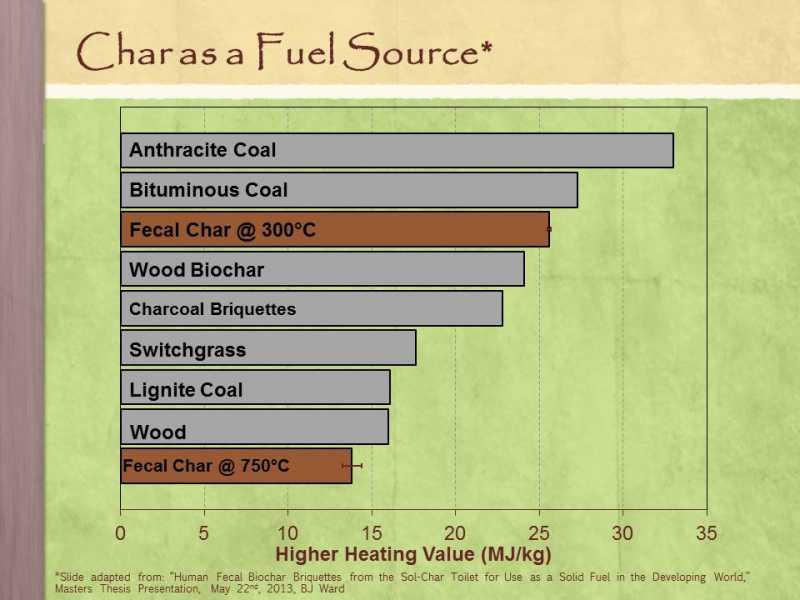 Sol-CharSu...nal2.jpg
(Filesize: 43KB)
Sol-CharSu...nal2.jpg
(Filesize: 43KB)
-
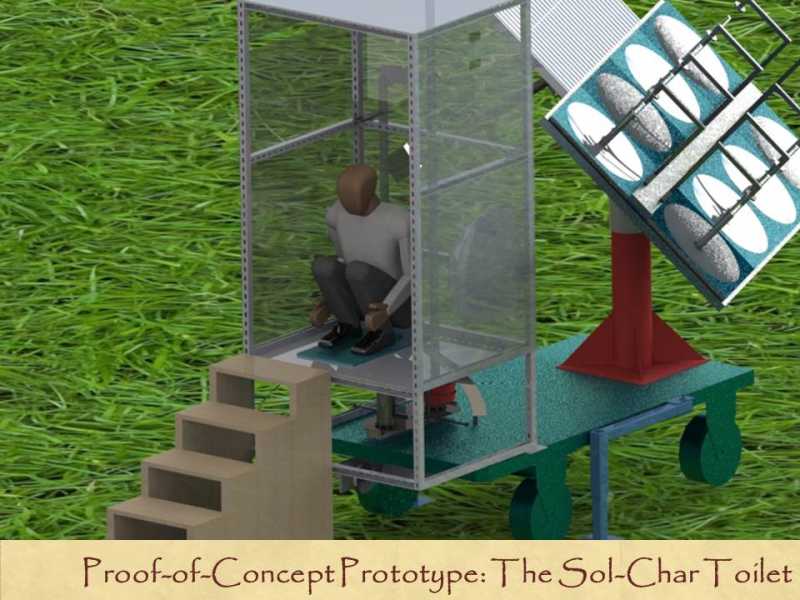 Sol-CharSu...nal3.jpg
(Filesize: 58KB)
Sol-CharSu...nal3.jpg
(Filesize: 58KB)
Please Log in to join the conversation.
You need to login to replyRe: Sol-Char Toilet: Using Concentrated Solar Energy to Treat Fecal Waste and Produce a Valuable Soil Amendment (Uni Colorado, USA)
To all those who are interested in this discussion on the Sol-Char Toilet: here is your chance to interact with Richard (Chip) Fisher and Ryan Mahoney live during the upcoming webinar hosted by SEI on Tuesday (26 Nov.) at 16:30 Sweden time.
During this webinar, you will get the chance to see a live presentation of the project and recent achievement and ask questions. Other participants are Alison Parker (Cranfield University, (Nano Membrane Toilet) and Jeroen Ensink (London School of Hygiene and Tropical Medicine, New concepts for on-site sanitation based on bio-additives and pit design).
Attendance at this webinar is open!
(If you miss the event live, you can view the recording on Youtube a few days later)
See here for more information: fhttp://forum.susana.org/forum/categories/139-general-information-and-announcements/5624-sanitation-expert-chats-bmgf-grantees-stockholm-environment-institute-invitation-for-4th-webinar-on-tuesday-26-november#6427 or contact: This email address is being protected from spambots. You need JavaScript enabled to view it.
Best regards
Dorothee
Developing methods and tools to support strategic planning for sustainable sanitation. Particular interested in novel technologies contributing to more inclusive and circular sanitation. This email address is being protected from spambots. You need JavaScript enabled to view it.
Please Log in to join the conversation.
You need to login to reply- richardpfisher
-

- Researcher at the University of Colorado at Boulder. Reactor team leader for the Sol-Char Toilet, a Reinvent the Toilet Challenge project funded by the Bill and Melinda Gates Foundation
Less- Posts: 5
- Likes received: 0
Re: Sol-Char Toilet: Using Concentrated Solar Energy to Treat Fecal Waste and Produce a Valuable Soil Amendment (Uni Colorado, USA)
Thanks for your comments and questions.
Unfortunately, I cannot quote a price on our prototype, mostly by the fact that it is a research unit to demonstrate our concept. There are too many caveats to determining that cost to enumerate in this forum.
As far as the possible uses to fecal biochar, all the applications you mentioned are certainly possible and fecal biochar's efficacy in each application depends on the feedstock properties (diet, water content, etc.) and processing conditions (temperature and heating rate of the reactor). The same can be said of any biomass feedstock used in pyrolysis to produce biochars. We're currently investigating the economic viability of all the above applications.
One of the more attractive applications for fecal biochar is its use as a solid fuel source. We've done studies in which we produced briquettes from biochar, processed at various reactor temperatures. It turns out that fecal biochars produced in the lower temperature range of pyrolysis have a higher heating value (HHV) greater than or equal to that of typical supermarket charcoal and greatly outperform the same biochar produced at much higher temperatures.
I apologize for not being able to answer your question about price tag of our prototype, so to speak, more specifically at this time but I hope I was able to address your other questions.
Thanks again,
-Chip Fisher
Please Log in to join the conversation.
You need to login to replyRe: Sol-Char Toilet: Using Concentrated Solar Energy to Treat Fecal Waste and Produce a Valuable Soil Amendment (Uni Colorado, USA)
Please Log in to join the conversation.
You need to login to reply- Resource recovery
- Resource recovery from excreta, faecal sludge or wastewater
- Production of biochar, fuel or electricity
- Sol-Char Toilet: Using Concentrated Solar Energy to Treat Fecal Waste and Produce a Valuable Soil Amendment - biochar (Uni Colorado, USA)







